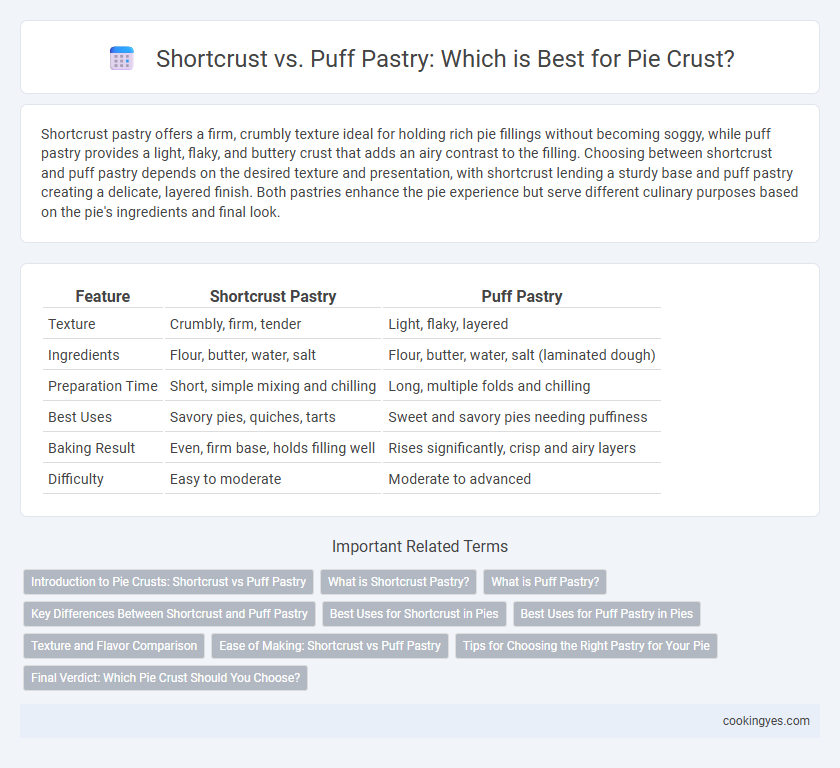Shortcrust pastry offers a firm, crumbly texture ideal for holding rich pie fillings without becoming soggy, while puff pastry provides a light, flaky, and buttery crust that adds an airy contrast to the filling. Choosing between shortcrust and puff pastry depends on the desired texture and presentation, with shortcrust lending a sturdy base and puff pastry creating a delicate, layered finish. Both pastries enhance the pie experience but serve different culinary purposes based on the pie's ingredients and final look.
Table of Comparison
| Feature | Shortcrust Pastry | Puff Pastry |
|---|---|---|
| Texture | Crumbly, firm, tender | Light, flaky, layered |
| Ingredients | Flour, butter, water, salt | Flour, butter, water, salt (laminated dough) |
| Preparation Time | Short, simple mixing and chilling | Long, multiple folds and chilling |
| Best Uses | Savory pies, quiches, tarts | Sweet and savory pies needing puffiness |
| Baking Result | Even, firm base, holds filling well | Rises significantly, crisp and airy layers |
| Difficulty | Easy to moderate | Moderate to advanced |
Introduction to Pie Crusts: Shortcrust vs Puff Pastry
Shortcrust pastry offers a sturdy, crumbly base ideal for savory and sweet pies, made primarily from flour, fat, and minimal water to ensure a tender yet firm texture. Puff pastry consists of numerous thin, flaky layers created by repeatedly folding dough around butter, resulting in a light and airy crust that rises dramatically during baking. Choosing between shortcrust and puff pastry depends on the desired pie texture and filling, with shortcrust favoring stability and puff pastry delivering crispness and volume.
What is Shortcrust Pastry?
Shortcrust pastry is a type of pie crust made from flour, fat, and a small amount of water, resulting in a firm and crumbly texture ideal for holding fillings. It is less flaky than puff pastry because it contains less fat and does not rely on layers for its structure. Often used in savory and sweet pies, shortcrust pastry provides a sturdy base that supports heavier ingredients without becoming soggy.
What is Puff Pastry?
Puff pastry is a light, flaky dough made by layering butter and dough through repeated folding and rolling, creating multiple thin layers that rise and crisp during baking. Unlike shortcrust, which is dense and crumbly, puff pastry results in a delicate, airy texture ideal for pies requiring a tender, buttery crust. Its high butter content and lamination process give puff pastry superior rise and flakiness, distinguishing it as a premium choice for decorative and textured pie crusts.
Key Differences Between Shortcrust and Puff Pastry
Shortcrust pastry is dense and crumbly, made from flour, fat, and water, providing a sturdy base ideal for savory and sweet pies. Puff pastry consists of multiple layers of dough and butter that rise during baking, creating a light, flaky texture perfect for delicate or decorative pie crusts. The key differences lie in texture, preparation complexity, and the ideal use--shortcrust offers stability for filled pies, while puff pastry emphasizes flakiness and visual appeal.
Best Uses for Shortcrust in Pies
Shortcrust pastry is ideal for pies requiring a sturdy, crumbly base that holds rich, dense fillings such as custards, fruit, or savory mixtures. Its buttery texture and low puff make it perfect for tarts, quiches, and classic fruit pies where a crisp, firm crust supports the filling without overwhelming it. Shortcrust excels in recipes demanding stability and a tender bite, ensuring the pie maintains structure during baking and serving.
Best Uses for Puff Pastry in Pies
Puff pastry works best for pies that benefit from a flaky, airy topping, such as fruit or savory pot pies, where its layers create a crisp, golden crust that contrasts with rich fillings. Its light texture is ideal for pot pies with creamy fillings like chicken or mushroom, providing a delicate balance without overpowering the ingredients. Puff pastry also excels in open-faced pies and tarts, offering an elegant presentation and satisfying crunch.
Texture and Flavor Comparison
Shortcrust pastry offers a dense, crumbly texture with a rich, buttery flavor that complements savory and sweet pies, creating a sturdy base that holds fillings well. Puff pastry delivers a light, flaky, and layered texture with a more delicate buttery taste, ideal for pies requiring a crisp, airy crust. The choice between shortcrust and puff pastry depends on whether a firm, hearty crust or a crisp, flaky shell best suits the pie's filling and overall flavor profile.
Ease of Making: Shortcrust vs Puff Pastry
Shortcrust pastry is easier to make at home due to its simple ingredients and straightforward mixing process, requiring minimal resting time. Puff pastry involves multiple folds and turns to create its flaky layers, making it a more time-consuming and technique-sensitive option. Novice bakers often prefer shortcrust for its reliability and quicker preparation compared to the intricate lamination needed for puff pastry.
Tips for Choosing the Right Pastry for Your Pie
Shortcrust pastry offers a crisp, crumbly texture ideal for savory pies and tart bases, while puff pastry provides a light, flaky, and buttery finish perfect for sweet pies and delicate fillings. Choose shortcrust when structural integrity is key, as it holds heavier fillings without sogginess. Opt for puff pastry when a visually impressive, airy crust is desired, especially for fruit pies or cream-filled desserts.
Final Verdict: Which Pie Crust Should You Choose?
Shortcrust pastry provides a firm, crumbly texture ideal for savory pies and tarts, offering excellent structure to hold heavy fillings. Puff pastry delivers a light, flaky, and buttery crust perfect for sweet fruit pies, adding layers of airy crispness. Choose shortcrust for stability and simple fillings, and puff pastry for richness and textured pastry in your pie crust selection.
Shortcrust vs Puff Pastry for Pie Crust Infographic

 cookingyes.com
cookingyes.com